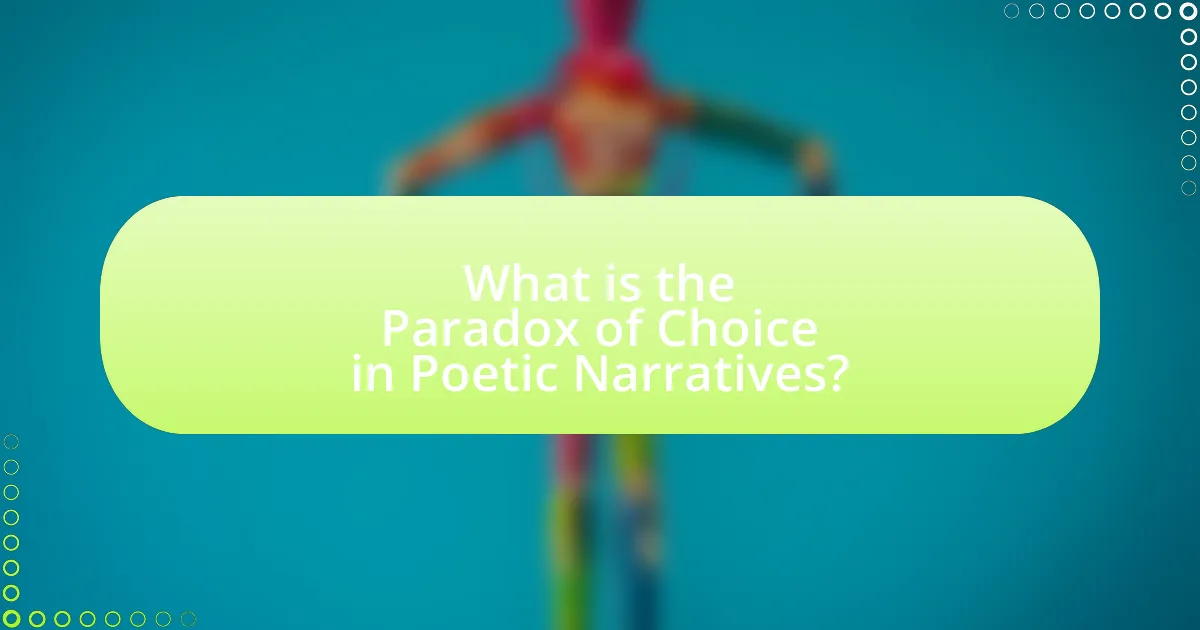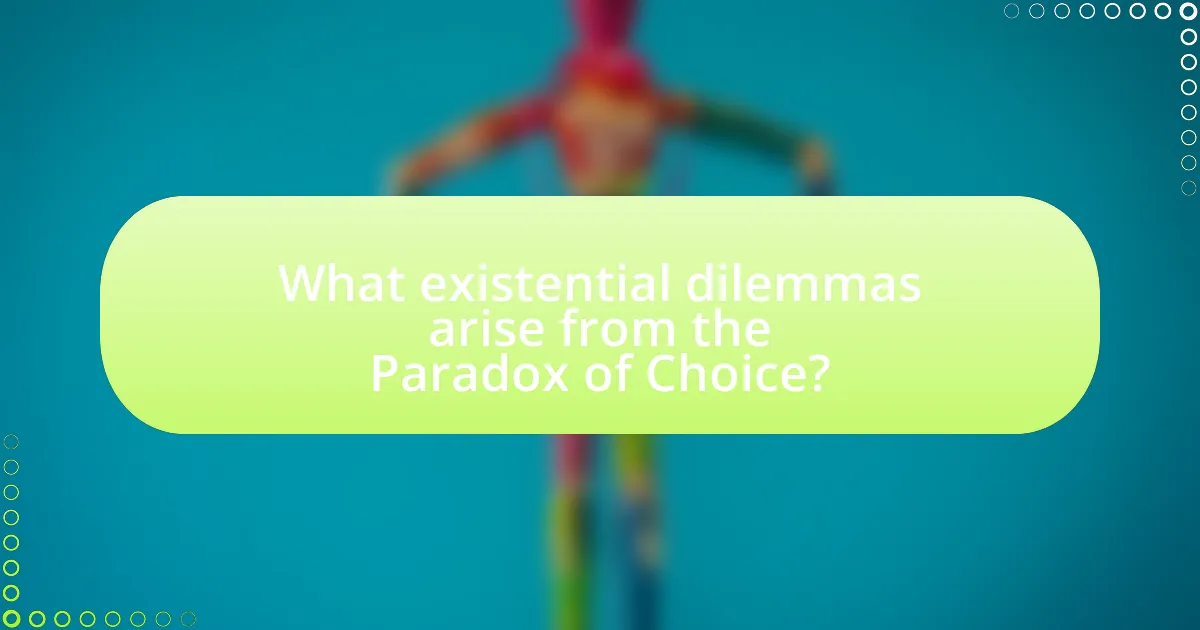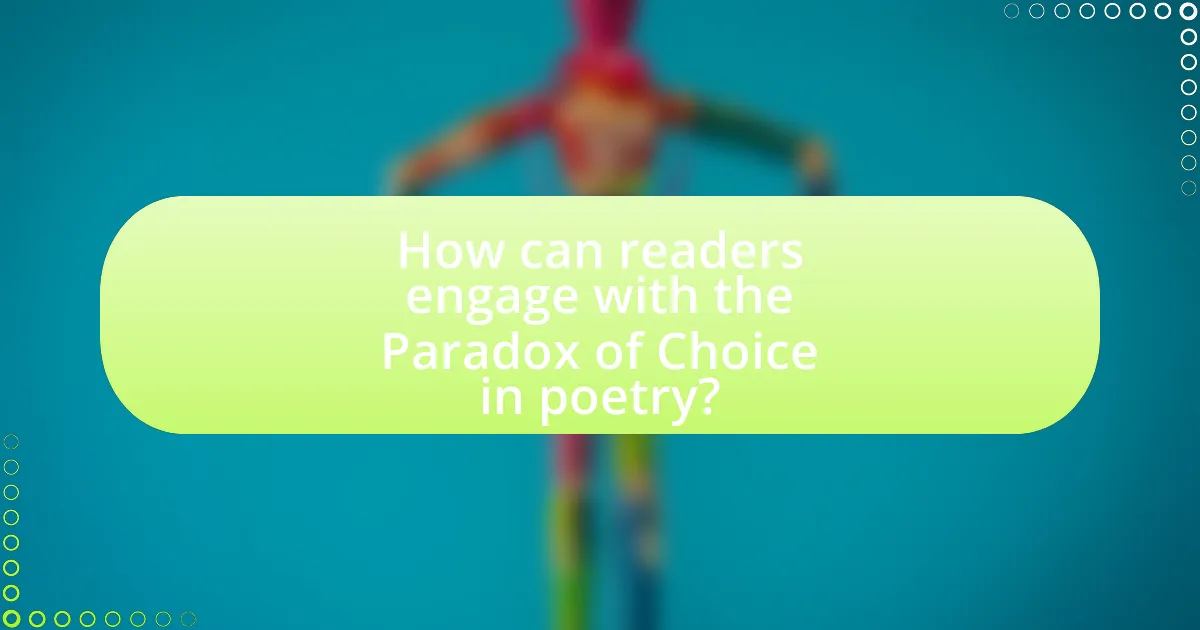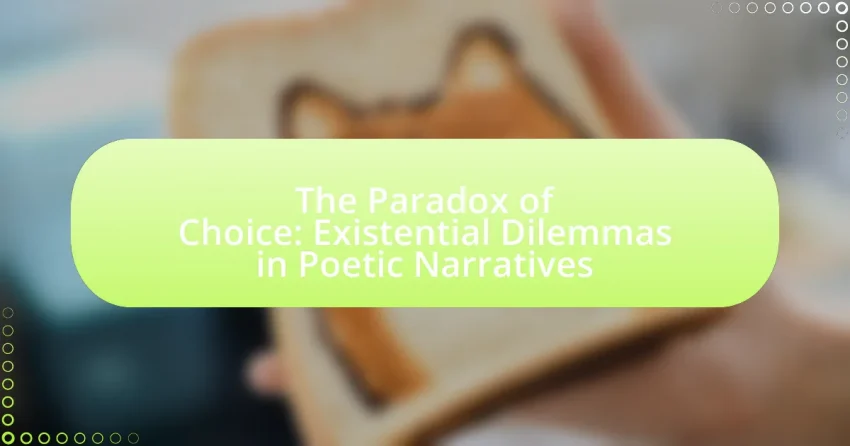The Paradox of Choice in poetic narratives refers to the anxiety and indecision characters experience when faced with multiple options, often leading to existential dilemmas. This article explores how this phenomenon manifests in poetry, impacting both the creative process for poets and the emotional journeys of characters. Key themes include the tension between freedom and constraint, the emotional weight of decision-making, and the psychological implications of choice. Notable examples from poets like Robert Frost and Sylvia Plath illustrate the complexities of choice and its effects on identity and meaning, while practical insights highlight the importance of simplifying choices to enhance clarity and emotional well-being.

What is the Paradox of Choice in Poetic Narratives?
The Paradox of Choice in poetic narratives refers to the overwhelming feeling of anxiety and indecision that arises when characters are presented with multiple options, leading to a sense of paralysis rather than liberation. This phenomenon is illustrated in various poetic works where the abundance of choices complicates the characters’ emotional journeys, often resulting in existential dilemmas. For instance, in Robert Frost’s poem “The Road Not Taken,” the speaker’s contemplation of two diverging paths symbolizes the weight of choice and its implications on identity and future. This reflects the broader psychological concept that while choice can enhance freedom, it can also lead to regret and dissatisfaction when faced with too many possibilities.
How does the Paradox of Choice manifest in poetry?
The Paradox of Choice manifests in poetry through the overwhelming number of stylistic and thematic options available to poets, which can lead to anxiety and indecision in the creative process. This phenomenon is evident as poets grapple with selecting from various forms, structures, and subjects, often resulting in a paralysis that hinders their ability to produce work. Research by Barry Schwartz in “The Paradox of Choice: Why More Is Less” illustrates that increased options can lead to decreased satisfaction and increased regret, a concept that applies to poets who may feel dissatisfied with their choices or fear missing out on better alternatives. Thus, the abundance of choices in poetry can create existential dilemmas, impacting both the writing process and the final artistic expression.
What are the key themes associated with choice in poetic works?
Key themes associated with choice in poetic works include existentialism, freedom versus constraint, and the emotional weight of decision-making. Existentialism often explores the individual’s struggle with the burden of choice, reflecting on how decisions shape identity and meaning. Freedom versus constraint highlights the tension between the desire for autonomy and the limitations imposed by societal norms or personal circumstances. The emotional weight of decision-making emphasizes the psychological impact of choices, illustrating feelings of anxiety, regret, or liberation that accompany the act of choosing. These themes are prevalent in various poetic narratives, showcasing the complexity of human experience in relation to choice.
How do poets express existential dilemmas through choice?
Poets express existential dilemmas through choice by illustrating the tension between freedom and responsibility in their works. This is evident in poems that depict characters facing critical decisions, where the weight of choice reflects the complexities of human existence. For example, Robert Frost’s “The Road Not Taken” presents a metaphorical crossroads, symbolizing the impact of choices on one’s life path, thereby highlighting the inherent uncertainty and regret associated with decision-making. Such representations serve to evoke the emotional struggle individuals face when confronted with significant life choices, reinforcing the idea that every decision carries profound implications for identity and meaning.
Why is the Paradox of Choice significant in literature?
The Paradox of Choice is significant in literature because it explores the complexities of decision-making and the emotional consequences of having too many options. This concept, popularized by psychologist Barry Schwartz in his book “The Paradox of Choice: Why More Is Less,” illustrates how excessive choices can lead to anxiety, regret, and dissatisfaction, themes that resonate deeply in literary narratives. For instance, characters often grapple with existential dilemmas stemming from their choices, reflecting the human condition and the struggle for meaning in a world filled with possibilities. This exploration of choice and its repercussions enriches literary works, providing insight into the psychological experiences of individuals facing overwhelming options.
What impact does choice have on character development in poetry?
Choice significantly impacts character development in poetry by shaping the characters’ identities and motivations. When characters face choices, their decisions reveal their values, desires, and internal conflicts, which are essential for their growth. For instance, in Robert Frost’s “The Road Not Taken,” the speaker’s choice between two paths symbolizes a pivotal moment that defines his character and future. This choice illustrates the weight of decisions and their lasting effects on one’s identity, emphasizing the existential dilemmas inherent in poetic narratives. Such moments of choice not only drive the plot but also deepen the reader’s understanding of the character’s psyche and the complexities of human experience.
How does the Paradox of Choice influence reader interpretation?
The Paradox of Choice influences reader interpretation by creating cognitive overload, which can lead to anxiety and indecision. When readers encounter multiple interpretations or meanings within poetic narratives, the abundance of choices can hinder their ability to derive a singular understanding. Research by Barry Schwartz in “The Paradox of Choice: Why More Is Less” demonstrates that too many options can result in decreased satisfaction and increased regret, which directly impacts how readers engage with and interpret texts. Consequently, this phenomenon can lead to a fragmented reading experience, where the richness of the narrative is overshadowed by the struggle to choose a coherent interpretation.

What existential dilemmas arise from the Paradox of Choice?
The Paradox of Choice leads to existential dilemmas such as decision paralysis, regret, and diminished satisfaction. Individuals often face overwhelming options, which can result in an inability to make choices, known as decision paralysis. This paralysis stems from the fear of making the wrong choice, leading to anxiety and stress. Furthermore, when choices are made, individuals frequently experience regret, questioning whether an alternative option would have led to a better outcome. Research by Barry Schwartz in “The Paradox of Choice: Why More Is Less” highlights that an abundance of choices can lead to lower satisfaction levels, as individuals may feel less content with their decisions due to the constant comparison with other available options. This cycle of anxiety, regret, and dissatisfaction illustrates the profound existential dilemmas that arise from the Paradox of Choice.
How do poets explore the concept of freedom in their works?
Poets explore the concept of freedom by using imagery, symbolism, and personal narrative to convey the complexities and nuances of liberation. For instance, in Walt Whitman’s “Song of Myself,” the poet articulates a sense of individual freedom through the celebration of self and the interconnectedness of all beings, emphasizing the idea that true freedom comes from embracing one’s identity and experiences. Similarly, Emily Dickinson often juxtaposes themes of confinement and liberation, as seen in her poem “I dwell in Possibility,” where she contrasts the constraints of societal expectations with the boundless potential of imagination. These examples illustrate how poets articulate freedom not merely as a physical state but as a profound emotional and existential journey, reflecting the paradox of choice inherent in the human experience.
What role does ambiguity play in the choices presented in poetry?
Ambiguity in poetry serves to enhance the complexity of choices presented to the reader, allowing for multiple interpretations and emotional responses. This multiplicity invites readers to engage more deeply with the text, as they must navigate the uncertain meanings and implications of the poet’s words. For instance, poets like T.S. Eliot often employ ambiguous imagery and language, which encourages readers to explore various themes and emotions, reflecting their own experiences and perspectives. This engagement with ambiguity can lead to a richer understanding of existential dilemmas, as it mirrors the inherent uncertainties in life and decision-making.
How do existential themes enhance the emotional depth of poetic narratives?
Existential themes enhance the emotional depth of poetic narratives by exploring fundamental questions of existence, identity, and the human condition. These themes evoke profound feelings of anxiety, isolation, and the search for meaning, which resonate deeply with readers. For instance, poets like T.S. Eliot and Sylvia Plath utilize existential motifs to convey the struggles of individuals facing the absurdity of life, thereby intensifying the emotional experience. The exploration of choices and dilemmas in their works reflects the complexities of human emotions, making the narratives more relatable and impactful. This connection between existential themes and emotional depth is evident in the way such poetry prompts introspection and empathy, allowing readers to confront their own existential questions.
What are the psychological implications of choice in poetry?
The psychological implications of choice in poetry include the exploration of identity, emotional expression, and the complexity of decision-making. Poetry often reflects the internal struggles individuals face when confronted with choices, highlighting how these decisions shape their sense of self and emotional landscape. For instance, the act of selecting specific words or themes can reveal deeper psychological states, such as anxiety or liberation, as seen in the works of poets like Sylvia Plath and T.S. Eliot, who grapple with existential dilemmas. Research indicates that the paradox of choice can lead to increased anxiety and dissatisfaction, as individuals may feel overwhelmed by options, a concept supported by Barry Schwartz in “The Paradox of Choice: Why More Is Less.” This demonstrates that the choices made in poetry not only influence the narrative but also resonate with the reader’s psychological experience, emphasizing the intricate relationship between choice and emotional depth in poetic expression.
How does the fear of making the wrong choice manifest in poetic expression?
The fear of making the wrong choice manifests in poetic expression through themes of indecision, anxiety, and existential questioning. Poets often explore the emotional turmoil associated with choices, using imagery and metaphor to convey the weight of potential regret. For instance, in works like Robert Frost’s “The Road Not Taken,” the speaker grapples with the implications of choosing one path over another, illustrating the internal conflict and uncertainty that accompany decision-making. This reflects a broader existential dilemma, where the fear of making irreversible choices leads to a profound sense of vulnerability and contemplation in poetic narratives.
What coping mechanisms do characters employ in response to choice-related dilemmas?
Characters employ various coping mechanisms in response to choice-related dilemmas, including rationalization, avoidance, and seeking external validation. Rationalization allows characters to justify their decisions, reducing cognitive dissonance and providing a sense of control. Avoidance involves evading the decision-making process altogether, often leading to inaction or procrastination. Seeking external validation entails looking for approval or guidance from others, which can help alleviate the burden of choice. These mechanisms reflect the psychological strategies characters use to navigate the complexities and anxieties associated with making significant choices, as seen in narratives that explore the paradox of choice.

How can readers engage with the Paradox of Choice in poetry?
Readers can engage with the Paradox of Choice in poetry by actively reflecting on the multitude of interpretations and emotional responses that a single poem can evoke. This engagement allows readers to confront their own decision-making processes regarding meaning and personal resonance, illustrating how the abundance of choices in interpretation can lead to both enrichment and confusion. Research indicates that the Paradox of Choice can lead to anxiety and dissatisfaction when faced with too many options, a concept supported by Barry Schwartz in his book “The Paradox of Choice: Why More Is Less,” where he discusses how excessive choices can overwhelm individuals. By analyzing various poems and their themes, readers can explore how different interpretations reflect their own values and experiences, thereby deepening their understanding of both the poetry and themselves.
What strategies can readers use to interpret poetic choices effectively?
Readers can interpret poetic choices effectively by analyzing the use of imagery, sound devices, and structure within the poem. Imagery allows readers to visualize concepts and emotions, enhancing understanding of the poet’s intent. Sound devices, such as alliteration and rhyme, contribute to the poem’s rhythm and mood, influencing emotional responses. Additionally, examining the poem’s structure, including stanza arrangement and line breaks, reveals how these elements shape meaning and emphasize key themes. For instance, a study by the University of California found that readers who focus on these elements demonstrate improved comprehension and engagement with the text, validating the effectiveness of these strategies.
How can understanding the Paradox of Choice enhance the reading experience?
Understanding the Paradox of Choice can enhance the reading experience by allowing readers to recognize how an abundance of options can lead to decision fatigue and dissatisfaction. When readers are aware of this phenomenon, they can approach their reading selections with a more focused mindset, reducing anxiety over choices and increasing enjoyment. Research by Barry Schwartz in “The Paradox of Choice: Why More Is Less” illustrates that too many options can overwhelm individuals, leading to less satisfaction with their final choice. By applying this understanding, readers can streamline their selections, prioritize quality over quantity, and ultimately foster a deeper connection with the texts they choose to engage with.
What are some notable examples of the Paradox of Choice in poetry?
Notable examples of the Paradox of Choice in poetry include Robert Frost’s “The Road Not Taken” and Wallace Stevens’ “The Emperor of Ice-Cream.” In “The Road Not Taken,” the speaker faces a choice between two paths, symbolizing life’s decisions and the inherent uncertainty that accompanies them. This poem illustrates how the abundance of choices can lead to regret and contemplation about the road not taken. Similarly, in “The Emperor of Ice-Cream,” Stevens presents a choice between the mundane and the profound, emphasizing the fleeting nature of life and the complexity of human desires. Both poems encapsulate the existential dilemmas that arise from having multiple options, highlighting the emotional weight of decision-making in human experience.
Which poets have effectively addressed existential dilemmas related to choice?
Poets such as T.S. Eliot, John Keats, and Sylvia Plath have effectively addressed existential dilemmas related to choice. T.S. Eliot’s “The Love Song of J. Alfred Prufrock” explores the paralysis of indecision and the fear of making choices, reflecting the complexities of modern existence. John Keats, in his poem “Ode to a Nightingale,” grapples with the tension between the desire for transcendence and the inevitability of mortality, highlighting the weight of choices in the face of fleeting beauty. Sylvia Plath’s “Lady Lazarus” confronts themes of identity and rebirth, illustrating the struggle with personal choices amidst despair. These poets provide profound insights into the human condition, emphasizing the significance of choice in shaping one’s existential experience.
How do specific poems illustrate the complexities of choice?
Specific poems illustrate the complexities of choice by exploring the emotional and psychological ramifications of decision-making. For instance, Robert Frost’s “The Road Not Taken” presents a metaphorical crossroads where the speaker must choose between two paths, symbolizing life’s choices and the inherent uncertainty of their outcomes. This poem highlights how choices shape identity and future experiences, emphasizing the weight of decisions and the regret that can accompany them. Similarly, Sylvia Plath’s “Lady Lazarus” delves into the struggle of self-reinvention and the choices that come with it, showcasing the tension between agency and societal expectations. These poems effectively convey the multifaceted nature of choice, revealing how it intertwines with personal identity, regret, and existential dilemmas.
What practical insights can be gained from the Paradox of Choice in poetic narratives?
The Paradox of Choice in poetic narratives reveals that excessive options can lead to anxiety and paralysis in decision-making. This insight highlights how characters in poetry often grapple with overwhelming choices, reflecting real-life dilemmas where too many possibilities hinder satisfaction and clarity. For instance, in Robert Frost’s “The Road Not Taken,” the speaker’s contemplation of divergent paths symbolizes the struggle with choice, illustrating how the burden of options can lead to regret and uncertainty. Such narratives emphasize the importance of simplifying choices to enhance emotional well-being and clarity in both literature and life.
